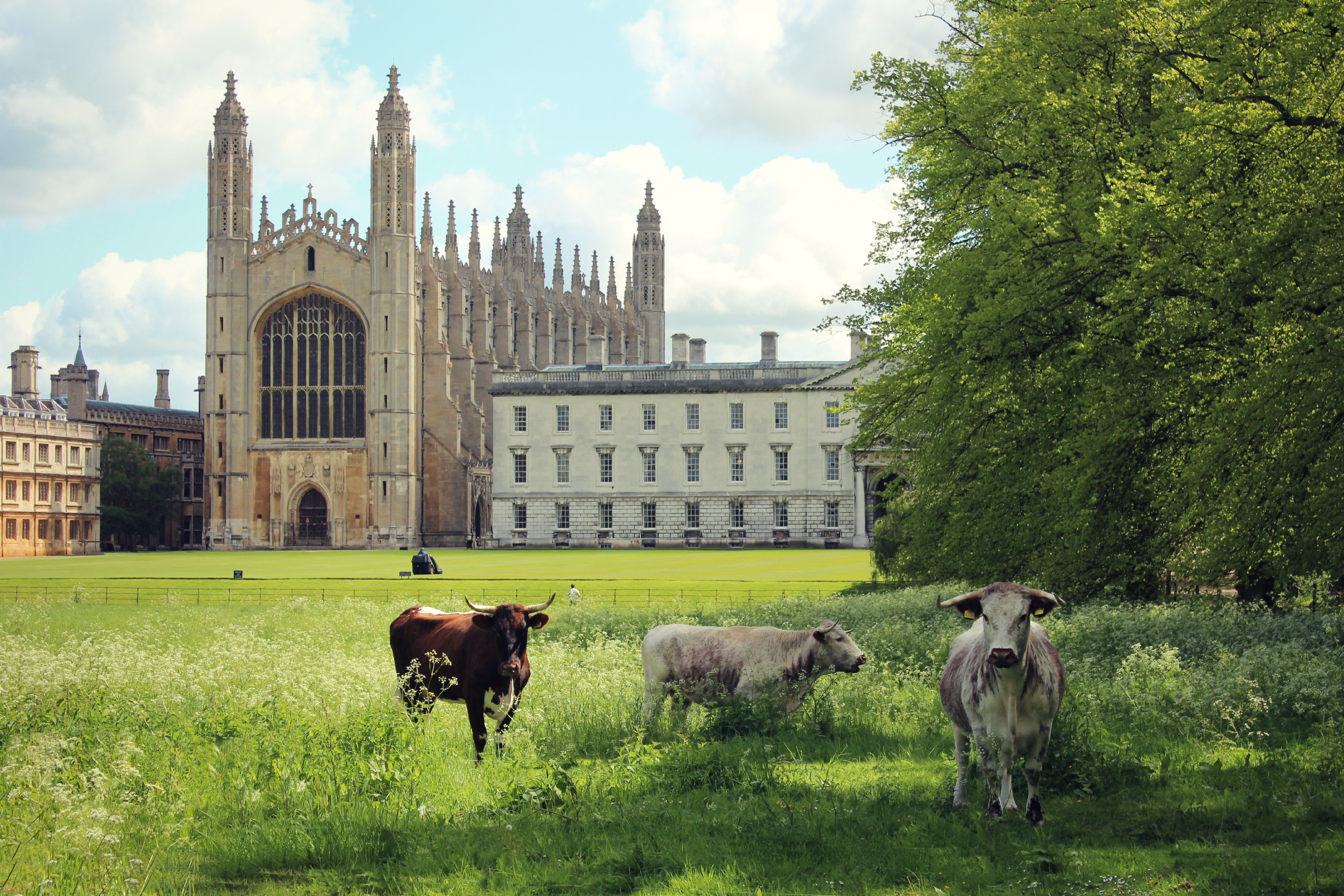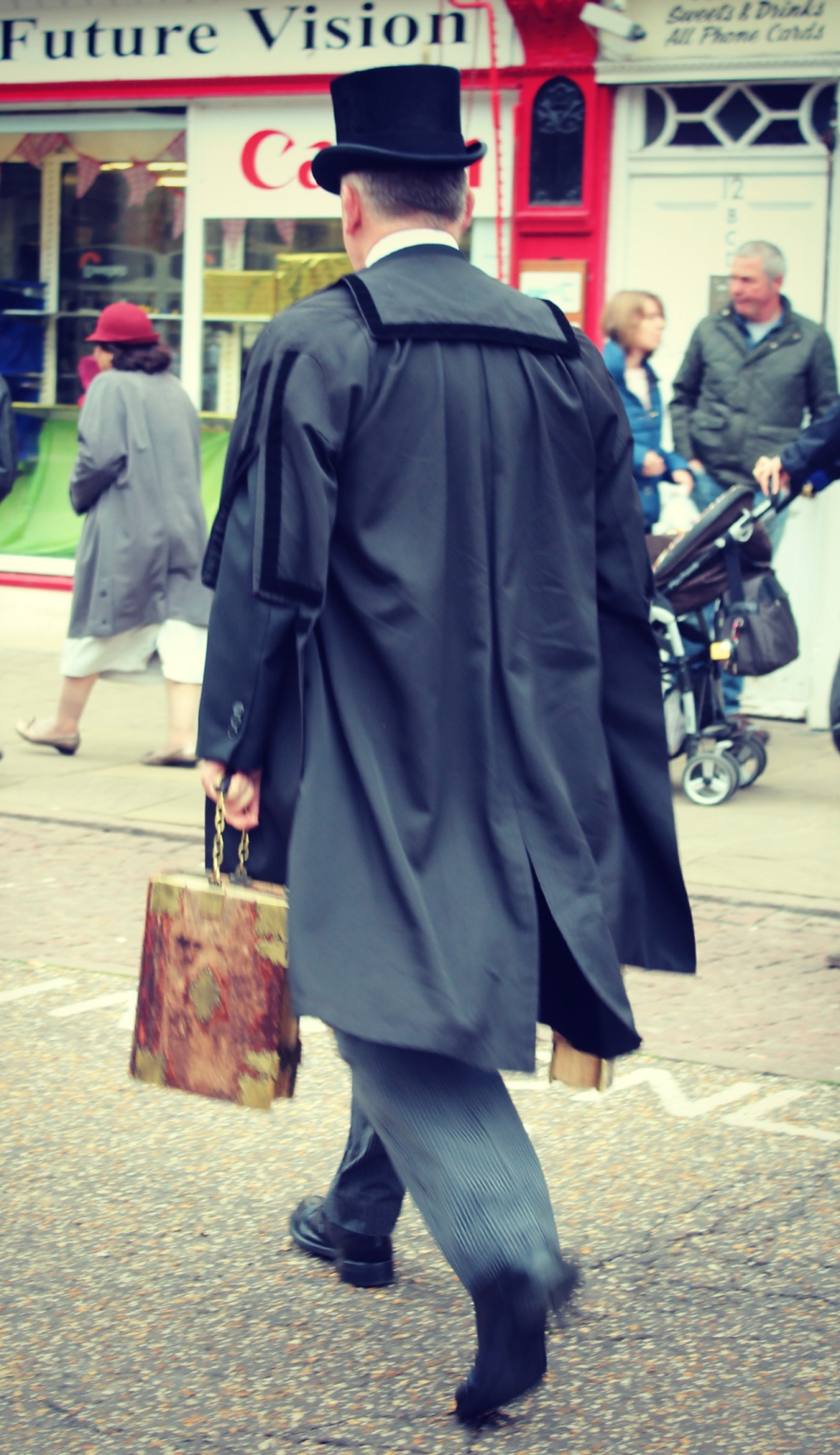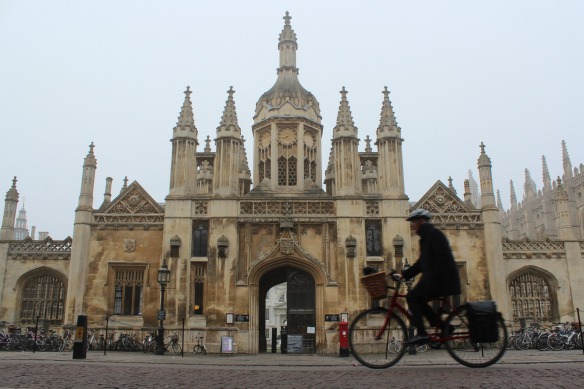
Fit for a King
 King’s is probably the most famous of Cambridge’s colleges on account of its magnificent chapel and famous choir. The Christmas Eve service is broadcast worldwide and marks the start of Christmas proper for many households ie not the shopping or decorating or going out for work’s Christmas parties but baking mince pies and gathering the family up and remembering where you stored the extra chairs….
King’s is probably the most famous of Cambridge’s colleges on account of its magnificent chapel and famous choir. The Christmas Eve service is broadcast worldwide and marks the start of Christmas proper for many households ie not the shopping or decorating or going out for work’s Christmas parties but baking mince pies and gathering the family up and remembering where you stored the extra chairs….

It also occupies a prime position on King’s Parade with access to the river behind and the Copper Kettle Coffee Shop in front. Its magnificent chapel took almost 100 years to build (1446-1544) but when you stand inside and look upwards and consider that it was built by hand it’s hard to conceive that it didn’t take much longer. Although famous for its chapel, it also has a magnificent Victorian gate house and even the Penfold letter box that stands outside is a listed building. The architecture is in fact a bit all over the place with various styles evident including some unedifying 20th century additions. It’s ironic that despite the availability of electricity and machines the architecture is bland – maybe if you knew people were going to pay with blood, sweat, tears and their lives to build your design you made sure it was worth doing.
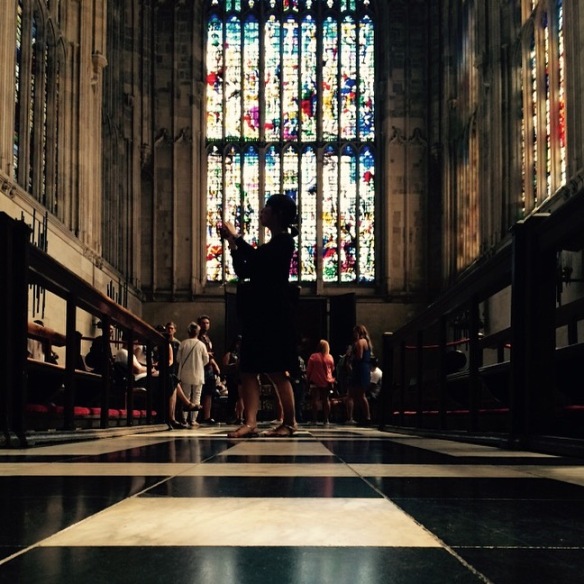
When it was founded by King Henry VI in 1441 all of the students were selected from Eton College and most were destined for Holy Orders. At the time Eton College provided a free education for poor boys so this destiny could have been far worse. 20th Century King’s certainly had a reputation for being more egalitarian than most and in 1965 when ‘High Table’ was moved to make access easier for Fellows it was no longer placed on a raised dais. Eight of those Fellows have been awarded Nobel Prizes but as Fred Sanger won two the college can claim nine.
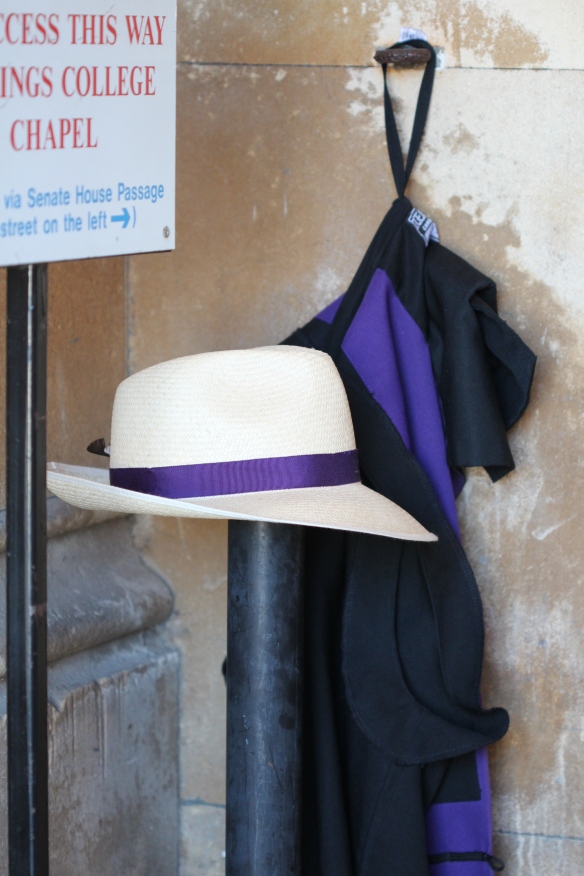
Other famous alumnae include literary types – EM Forster, Rupert Brooke, Zadie Smith, Salman Rushdie and the much loved Chinese poet Xu Zhimo who is single-handedly responsible for the many Chinese tourists who visit Cambridge each year in search of the beauty he immortalised. We hope that they visit more than once so they can properly understand the poem ‘Second Farewell to Cambridge’!
Having a Ball
Cambridge May Balls were ‘invented’ by the Trinity College Boat Clubs who customarily held a dinner to celebrate the end of the May Bumps (see previous blog!). Prior to 1882 these actually took place in May, in the week before the end of year exams but, presumably to encourage more exam success, the races and revelry were moved to the middle of June. These days they are very large, lavish and grand affairs and although expensive they are still popular with students celebrating the end of exams, or indeed the end of their time at Cambridge. Tickets can be hard to come by but they are open to anybody who wants to buy one, you don’t need to be a student or a member of the university.
To be fair the Trinity Boat Club dinners that predated the balls were not sober affairs either. The dinner of 1838 was held at the Hoop Inn and was attended by 38 members of the rowing club. Before the Junior Proctor found them and broke up the party they managed to consume “47 bottles of Champagne, 12 of Sherry, 6 of Mosel and 2 of Claret, besides 6 quarts of ale and £16 14s of punch!” In 1866 the Boats Clubs began holding ‘proper’ May Balls in hotels but they soon moved to marquees set up on the college lawns – and there they remain. The Trinity Ball is still one of the largest and most extravagant and it unfortunately also attracts hungry journalists desperate to get photos of over-privileged students behaving badly the morning after the night before. Obviously with unlimited free alcohol available all night and students who have just gone through the most stressful few weeks of their lives (with exams rapidly followed by results) they don’t have to try too hard to find their photos.
Other colleges soon followed Trinity and organized their own balls which follow a general format of lavish decoration, food, drink, entertainment, breakfast at dawn and a survivors photo at 6am but have their own distinctive characters. Peterhouse, a rather conservative college, always features a ferris wheel and is one of the few that still strongly prefers white tie. Identifying what this involves would be quite stressful for your average student having to do a crash course in formal dress, but Debenhams will knock you up the necessary ‘evening tails’, white waistcoat, wing collar shirt and white bow tie for £85 for an evening’s hire. You can also wear military uniform or national dress should you happen to have them. Women of course have an even greater dilemma as they can choose pretty much what they want!

I liked these two – quite ‘Made in Chelsea’ ! She’ll be needing that cardy – no matter how warm it is during the day it’s always cold at 3am.
St. John’s is marginally less formal with a black tie dress code and is one of the biggest balls, with the different areas of the college transformed for dancing, funfairs, casinos, balloon rides and the list goes on. They have had some real coups on the music side with recent appearances from Dizzee Rascal, Ellie Goulding and Scissor Sisters. ‘Ents’ is a closely guarded secret so that colleges don’t steal acts from each other and speculating about the possible ‘stars’ is part of the fun of the balls. Both Trinity and St John’s have massive firework displays which are best viewed from a punt on the river and can be enjoyed by anybody willing to stay up long enough – but are an irritation in our household due to the presence of a nervous spaniel.
Clare College has perhaps the most romantic setting, and last year the ball had an Alice in Wonderland theme with the cellars transformed into a rabbit hole and a Mad Hatters Tea Party in the Fellows Garden. This year was altogether more serious – based on the Divine Comedy – I’m not sure I’d fancy too long in Dante’s Inferno.

As many tickets are sold in pairs there is extra planning required by friends of singles. This little scene reminded me of a friend of mine managing to arrange a blind date for a Spanish language student who was working as a waitress in college and a Swedish graduate student. Pilar was terribly nervous and made me promise that we’d stick with her at the ball. But it was love at first sight and we only caught a glimpse of a radiantly happy beautiful girl as she whirled around the ball with her handsome partner! These two look pretty happy as well but he does need to lose that bag!
Obviously the balls are expensive – you can spend from £150 to over £400 on a double ticket. The balls are decadent – you can argue that they cater to posh kids letting themselves go and ‘letting themselves down’ but they also have a good side. Many a student has gained valuable experience (and ultimately a job) from arranging a ball, they provide welcome extra income for local businesses and individuals – caterers, musicians, punt companies, waiting staff, security etc and they make large donations to charities. And they are a fun, blow out night which allow many ordinary students to dress up, dance the night away, get drunk and celebrate the end of three years of hard studying before starting ‘real jobs’. The comedy acts regularly make fun of the ‘poshness’ of the events – with students laughing at themselves, knowing that the vast majority will be back to being ordinary kids with a headache the following day.
Sources:
http://www.firstandthird.org/tables/club/history.shtml
Things that go bump
It’s May Bumps week in Cambridge which means that there is vaguely organized chaos on the river from Wednesday to Saturday. The Cam is mostly too narrow for side by side racing and The Bumps is a way for all of the Colleges to race against each other at the same time. Sets (‘divisions’) of 17 boats row all the way down the river to Bait’s Bite lock, turn around and pull into the bank at intervals of 90 feet (ie they have 1.5 boats length between them). The order of racing is set by the previous year and as the members of the crews change year on year it’s all a bit random how well you do. When the first canon goes off the boats are pushed out into the river with the coxes holding on to a ‘bung’ on the end of a chain. This part takes some coxing skill as you don’t want your boat to start at an angle and fines are administered for ‘dropping the bung’ which is often necessary to keep your boat straight. When the second canon goes off you drop your bung and grab your rudder string ASAP as the crew goes off full pelt and you need to keep control. The aim is to catch the boat in front and hit it before you get hit from behind. If you manage to bump the boat ahead you both pull into the bank to make room for the boats behind you to go past. Obviously if the boat in front of you manages to bump the boat ahead of them before you catch them you now have your work really cut out and you have to go for an ‘overbump’ – you try and catch the boat that started three ahead of you. These are fairly unusual occurrences and only tend to happen when the first boat has some sort of catastrophe – eg losing an oar or catching a major crab (getting the oar stuck in the water which can actually catapult the rower out of the boat). In the next day’s racing you swap places and go ahead of the boat you bumped. The aim is to bump up on four successive days and if you succeed you win your oar (which means you can pay quite a lot to get an oar painted with your college crest and team names)
The most exciting races in my opinion happen early in the day – these are the less experienced and more casual boats and there is generally lots of bumping and general mayhem as inexperienced coxes try to pull into the bank after a bump. The boat that finishes at the front of each division moves up and rows again at the back of the next division and the process is repeated until you get to the final division of the day which has the college first boats competing– usually sleek-looking professional crews with fewer bumps and definitely fewer ‘other incidents’. The college that finishes at the front of ‘First Division’ (which is run last) goes ‘Head of the River’ and a pagan-style boat burning ceremony and much alcohol-fuelled celebration occurs during the evening.
Needless to say quite a lot of boat damage occurs and the boatmen of the colleges are kept very busy. Rarer but not uncommon is injury to rowers, coxes and spectators (especially those cycling into the river by accident) but fortunately the story of St. John’s attaching a sword to their bow and killing a Trinity cox is not actually true!! However, there is no smoke without fire and the reason that all boats must have ‘bow balls’ is because of terrible accident in which a Trinity Hall boat ploughed into a Clare boat that had pulled into the bank, hitting a rower and killing him instantly. Had I known that I may have been less willing to cox – even so I suspect that the panic in my voice is what inspired the rowers to go faster and I’m happy to say that I was never bumped. I don’t have any photos of me coxing the May Bumps but here I am with the LMBC (St John’s) Fifth Boat (yes fifth!) in the Lent Bumps in about 1987.

Approaching the bend – often a good place for bumps and I’m steering a particularly good line here because I happened to have an excellent cox on the bank telling me what to do!! We rowed almost the entire course here and managed to get a bump just before the finish at the Pike and Eel pub – very unusual to bump so late and REALLY exciting to watch from the cox’s position!
For more information have a look at http://www.cucbc.org/bumps/how_bumps_work. You can also read the ‘Fines’ page – some of the misdemeanours and fines can be quite amusing.
On Common Ground
Monty and I have been banished from our favourite playing area on Jesus Green this week by a combination of the Cambridge Beer Festival and the sunshine which has brought out sunbathers and picnickers en masse. Not many people see the funny side of a black and white spaniel running off with their brie and grape baguette so we headed off onto some of Cambridge’s less ‘tidy’ Commons. Midsummer Common is close to the centre of town and it well known as the site of the huge annual Midsummer Funfair, the city firework display and the more recent arrival, Strawberry Fair. The slightly scrubby area, often featuring grazing cows, is very popular with joggers and dog-walkers but doesn’t look particularly interesting in its own right. However, scratch the surface and its history is fascinating. In the 12th century the area was common land but permission to run a Midsummer fair there was granted to the powerful Barnwell Priory in 1211. This was a lucrative venture for the Priory and allowed them to impose a moral code on the Midsummer celebrations. It was a time for the youth of the city to impress with ‘athletic feats’ and there are still plenty of athletic youths running and rowing in the area. I suspect it’s never been an area that you’d want to wander around alone at night and in the 1630’s you wouldn’t want to wander there in the daytime either – as it was on the outskirts of the city 40 booths were erected for the treatment of plague victims and their bodies were buried in pits. Better not to scratch the surface too deeply in fact… Midsummer Fair transformed from a trade fair into a funfair and all manner of ‘attractions’ have been displayed on the Common over the years, including elephants and a flea circus. The Friends of Midsummer Common report that the 1905 Midsummer Fair ‘was described as a “Bacchanalian orgy” as people were behaving “like maniacs”. There were 14 tents supplying intoxicating liquors and the behaviour in the tents was “indescribable” – 5 perambulators were seen standing unattended outside one tent.’ This made me smile – no point in complaining about the relatively tame Beer Festival or the drugs and drink shenanigans at Strawberry Fair. There are some standards to maintain however – you can still be fined 40 shillings for shaking out a carpet on the Common!
A little further east and King John has granted a charter to the Leper Hospital to hold a fair on Stourbridge Common. Between the 13th and 19th Centuries Stourbridge Fair grew to be the most important trade fair in Europe. Every year in September temporary streets of wooden booths grew up and everything could be bought from gold to herbs, oysters to Murano glass. Goods came from Europe, up river from King’s Lynn, and by road from all around the country. John Bunyan based Vanity fair on Stourbridge and in 1665 a young Isaac Newton bought some astronomy books and a glass prism with which he later split light. Realising the money-making opportunities, the University attempted to wrestle control of the Fair from the town – they didn’t succeed but they were allowed to control ‘weights and measures’. This delighted the Proctors and Constables (see last week’s post) who promptly invented all sorts of rules and regulations and fined people who failed to comply. Towards the end of each Fair the trade stalls gave way to entertainments – giants, faeries and three-legged cats vied for attention. Of course the University students flocked to the gambling and lewd behaviour and the University tried to have it all banned. They did succeed in closing down the theatre booth but it didn’t stop the Masters and Clergy from several colleges enjoying the entertainment! Moving into the 19th century the Fair had competition from permanent shops and commercial centres and the Victorians disapproved of the thieves, gamblers and prostitutes that the Fair attracted, so that it gradually diminished in size and importance. In 1933 the Fair consisted of one young man with an ice cream cart, and in 1934 there was nothing. It’s very hard to imagine a bustling Fair when you wander along the riverbank watching the rowers but I like to the fact that you can hear the clanging of industrial units and the busy traffic on Newmarket Road in the distance. It’s a reminder that this industrial area was also a vital part of the history of the city and we, along with the herons and swans and kingfishers, can thank Stourbridge Fair for saving the meadows.
Sources:
Click to access Riverside%20and%20Stourbridge%20Common%20Draft%20Appraisal%20-%20Appendix%203.pdf
Great British Bulldogs
 Even the unseasonably cold weather couldn’t depress this huddle of University Constables – commonly known as Bulldogs – that I encountered outside King’s College on Sunday morning. There are about 20-30 constables belonging to the university at any one time. They are sworn in as Special Constables and have the same powers but only within a 5 mile radius of Great St Mary’s Church. They report to the University Proctors and are responsible for maintaining student order around the town with special responsibility to ensure free speech. These days they manage crowds at official ceremonies and make sure that student debates and demonstrations pass off fairly and peacefully.
Even the unseasonably cold weather couldn’t depress this huddle of University Constables – commonly known as Bulldogs – that I encountered outside King’s College on Sunday morning. There are about 20-30 constables belonging to the university at any one time. They are sworn in as Special Constables and have the same powers but only within a 5 mile radius of Great St Mary’s Church. They report to the University Proctors and are responsible for maintaining student order around the town with special responsibility to ensure free speech. These days they manage crowds at official ceremonies and make sure that student debates and demonstrations pass off fairly and peacefully.
But they must have had quite a bit more fun when they patrolled the streets around the colleges with the thankless task of upholding the moral fibre of the students (up until the 1960s). They went in search of students who were out and about without their gowns and caps, climbing in and out of colleges after the curfew, being drunk and disorderly and/or consorting with women of dubious moral fibre. In fact they could also arrest the women and had a prison of their own called the Spinning House where the ladies were discouraged by the Town Crier wielding his whip! In the 1930’s the famous ‘night climbers’ who climbed King’s College Chapel amongst other places were at risk not only of falling off but of being caught by the Proctors and rusticated. The constables can still be armed with pikes, haliberds, truncheons and buttersticks but I don’t believe they’ve been used in anger for quite some time!
I don’t know what the gathering on Sunday was in aid of but one of the group was carrying the two leather books that contain the University Statutes so maybe this is what happens when somebody wants to study the rulebook!
Sources:
http://www.christs.cam.ac.uk/darwin200/pages/index.php?page_id=i2
http://www.workhouses.org.uk/Cambridge
http://www.admin.cam.ac.uk/offices/proctors/constabulary/
http://www.tcs.cam.ac.uk/the_bridge/features/the-cambridge-‘bulldogs’/
Thanks for looking!
For the last 18 months I have been creating a photo diary on http://www.365project.org which has involved pounding the streets of Cambridge and its surroundings with my dog Monty and a camera. I have discovered so much that I didn’t know about the city I love and have come across weird and wonderful, quirky and creative, inspiring and heartbreaking individuals. I hope to use this forum to share some of these discoveries with visitors, locals and people who can only view from afar. I also hope to showcase some of the small enterprises that add to the richness of our community and to discover new hidden gems along the way. So I really hope this will be an interactive process. Fingers crossed and thanks for looking!
